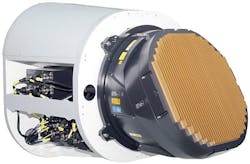Air Force picks Raytheon and Northrop Grumman to attack costs and complexity of AESA radar
WRIGHT-PATTERSON AFB, Ohio, 5 June 2014. Two of the nation's leading military radar houses are trying to develop new manufacturing processes for active phased array military radar to increase system reliability while reducing development time and costs.
Radar experts at the Raytheon Co. Space and Airborne Systems segment in El Segundo, Calif., and the Northrop Grumman Corp. Electronic Systems segment in Linthicum Heights, Md., received contracts Wednesday for the Affordable Radio Frequency Multifunction Sensors (ARMS) program.
Awarding the contracts were officials of the Air Force Research Laboratory's Materials and Manufacturing Directorate at Wright-Patterson Air Force Base, Ohio. Raytheon won a $7.1 million ARMS contract and Northrop Grumman won a $3.8 million ARMS contract.
The ARMS program centers on developing new manufacturing processes to enable an increase in reliability and a decrease in cycle time and costs for active electronically scanned array (AESA) radar sensors.
Related: Air Force considering AESA radar upgrades for B-1 and B-52 strategic bomber fleets
AESA radar uses transmitters and receivers that are composed of many small solid-state transmit and receive modules. AESA radars aim their beams by emitting radio waves from each module in different phases to focus radar energy in different directions.
This kind of radar particularly lends itself to digital processing, and enables radar steering without a traditional rotating antenna. Omitting moving parts from the system increases reliability and reduces the need for constant maintenance.
As useful as these kinds of radar systems are, they are increasingly expensive and time-consuming to develop and manufacture, Air Force officials say. Next-generation aircraft must provide the warfighter with increased situational awareness in highly integrated airspace.
Related: Air Force chooses Lockheed Martin to design and build Space Fence radar to track space junk
This places a heavy burden on AESA radar systems, which must have increasing bandwidth, capability, functionality, and performance for new generations of high-performance military aircraft.
AESA sensors must be thin and lightweight which forces the design to be highly integrated, Air Force researchers say. The size and performance requirements for these systems drive the array architecture to be very difficult to manufacture, test, and expensive to build.
Raytheon and Northrop Grumman engineers are aiming to change all that.
The contracts announced Wednesday to Raytheon and Northrop Grumman are for the two-year first phase of the ARMS program, which calls for Raytheon and Northrop Grumman to identify the primary challenges of developing new AESA radar manufacturing processes, as well as establish key performance parameters.
Near the end of the ARMS program's first phase, Air Force experts will determine whether or not they will pursue a two-year second phase. If they do, the program's second phase would continue development to bring ARMS technology to a level of maturity sufficient to demonstrate the technology's viability.
The goal of the ARMS program ultimately is to focus on reducing cycle time, part count, labor, costs of AESA sensors for next-generation aircraft.
Raytheon will do the work on the ARMS program in El Segundo, Calif., while Northrop Grumman will do the work in Linthicum Heights, Md. Both companies should be finished by March 2016.
For more information contact Raytheon Space and Airborne Systems online at www.raytheon.com, Northrop Grumman Electronic Systems at www.northropgrumman.com, or the Air Force Research Laboratory at www.wpafb.af.mil/afrl.

